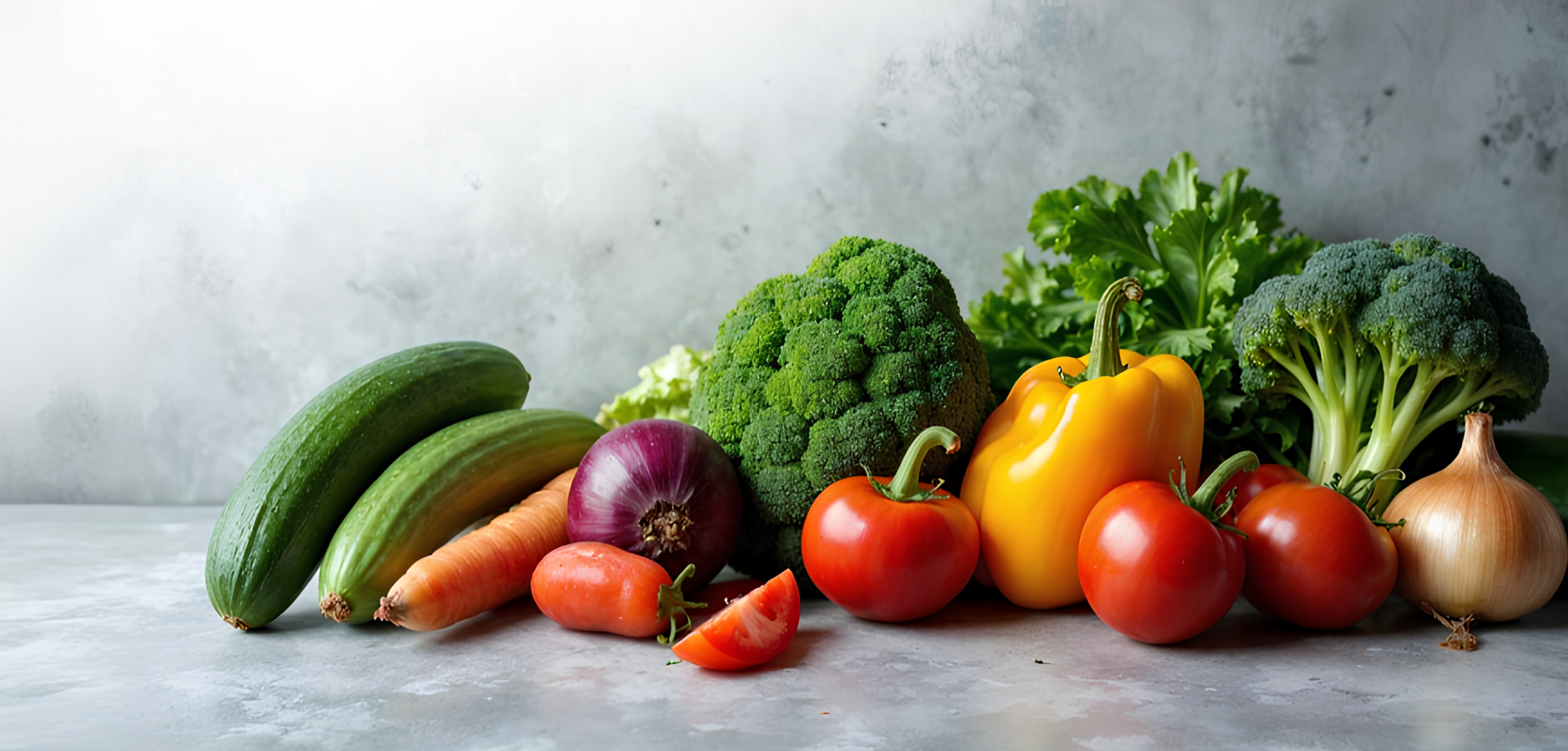Why do we know we should eat vegetables, but still don’t do it?
~ 5 min read
19 May 2025
We’ve all heard the simple advice: “Eat more vegetables — it’s the foundation of good health.” Yet the reality is that most people worldwide fall short of even the minimum recommendations for fruit and vegetable intake. This isn’t just a matter of habit — it’s a complex mix of psychological, biological, and social factors.
Let’s unpack why this happens.
1. The Brain Isn’t Wired for Vegetables
Evolutionarily, our brains are tuned to seek out high-calorie, quick-reward foods — a survival mechanism leftover from times of scarcity.
Highly processed foods — fast food, sweets, fatty items — trigger a strong dopamine response that makes our brains “feel good.”
Vegetables, despite their health benefits, often have a bitter taste caused by phytonutrients, which elicit a much weaker reward response in the brain’s pleasure centers.
Neuroscience research (Small et al., 2015) shows sugary and fatty foods activate the striatum — the brain’s pleasure and habit formation center — far more strongly than vegetables. That’s why even with the best intentions, we often reach for the easier, more immediately rewarding choices.
2. Physiological Reasons for Vegetable “Intolerance”
-
Microbiome disruption: The gut microbiome plays a crucial role in digesting fiber from vegetables. After antibiotics, stress, or poor diet, this balance can be disturbed, causing discomfort, bloating, and gas.
-
FODMAP sensitivity: Fermentable carbohydrates found in many vegetables (onions, garlic, broccoli, apples) can trigger symptoms in people with irritable bowel syndrome.
-
Oral allergy syndrome: Cross-reactions to pollen and raw vegetables can cause itching, throat irritation, or swelling in individuals with seasonal allergies.
According to the NIH, 15-20% of the population exhibits increased sensitivity to certain vegetables, especially those containing sulfur compounds or soluble fibers.

3. The Paradox of “Dietary Discipline”
There’s a big gap between knowing and doing. Behavioral economics shows that people choose immediate gratification even when aware of long-term risks.
The “hyperbolic discounting” theory explains why short-term rewards (like sweets or fried foods) often win over the long-term benefits (like vegetables).
4. The Quality of Vegetables Is Another Challenge
Even those who eat vegetables may not get all the nutrients they expect due to:
-
Soil depletion caused by intensive farming
-
Choosing high-yield crop varieties with lower micronutrient content
-
Extended storage and transportation that degrade vitamin levels, especially vitamin C
Research by Davis et al. (2004) documented significant declines in protein, calcium, phosphorus, iron, riboflavin, and vitamin C in most U.S.-grown vegetables between 1950 and 1999.
5. The Realities of Modern Life
Meeting the recommended 400-500 grams of vegetables daily requires buying, preparing, storing, and knowing how to combine them.
In today’s fast-paced world, this often feels like an overwhelming task — even for those genuinely committed to healthy eating.
Greespi — A Smart Solution for Modern Living
A functional food that:
✅ Contains up to 71% complete protein with all essential amino acids
✅ Provides organic iron, calcium, magnesium, vitamin B12, and chlorophyll
✅ Offers high bioavailability (up to 95%)
✅ Does not cause bloating or intolerance
✅ Supports gut health and immune function
Two daily servings of Greespi help compensate for key micronutrient gaps without extra effort or doubts about quality.
Explanation, Not Judgment
We don’t avoid vegetables out of laziness or neglect. Our food choices are shaped by complex biological, psychological, and social factors.
Greespi is an adaptive solution that works where traditional diets often fall short.
References:
-
Richmond, A. (1986). Handbook of Microalgal Mass Culture. CRC Press.
Detailed analysis of the protein profile of Arthrospira (60-70% protein) and its complete amino acid composition. -
Becker, E.W. (2007). Micro-algae as a source of protein. Biotechnology Advances, 25(2), 207-210.
Confirms the high bioavailability of Arthrospira protein (PDCAAS = 0.75–0.89). -
Karkos, P.D. et al. (2011). Arthrospira in Clinical Practice: Evidence-Based Human Applications. Evidence-Based Complementary and Alternative Medicine.
Review of clinical studies on the content of vitamins B12, iron (28 mg/100 g), and antioxidants in Arthrospira. -
Kulshreshtha, A. et al. (2008). Arthrospira in Nutrition and Health. International Journal of Food Sciences and Nutrition. Data on the high content of β-carotene (10 times more than in carrots) and chlorophyll.
-
Capelli, B., Cysewski, G.R. (2010). Potential health benefits of Arthrospira microalgae. Nutrafoods, 9(2), 19-26. Comparison of iron absorption from Arthrospira (95%) vs synthetic supplements (20%).
-
Selmi, C. et al. (2011). The effects of Arthrospira on anemia and immune function in senior citizens. Cellular & Molecular Immunology, 8(3), 248-254.
-
Parada, J.L. et al. (1998). Lactic acid bacteria growth promoters from Arthrospira platensis. Journal of Applied Phycology, 10(4), 375-379. Prebiotic properties of Arthrospira for beneficial gut bacteria.
-
Small, D.M., DiFeliceantonio, A.G. (2015). Processed foods and food reward. Science, 363(6425), 346-347. This study explores the impact of processed foods on the brain’s reward system.
-
National Institutes of Health (NIH). (2020). Food Intolerances vs Food Allergies.
Official data on the prevalence of food intolerances. -
Ainslie, G. (1975). Specious reward: A behavioral theory of impulsiveness and impulse control. Psychological Bulletin, 82(4), 463-496. A classic work on hyperbolic discounting theory, explaining impulsive decision-making.
-
Davis, D.R., Epp, M.D., Riordan, H.D. (2004). Changes in USDA food composition data for 43 garden crops, 1950 to 1999. Journal of the American College of Nutrition, 23(6), 669-682. This research shows the decrease in nutrient value of vegetables over the last 50 years.
-
Gibson, P.R., Shepherd, S.J. (2010). Evidence-based dietary management of functional gastrointestinal symptoms: The FODMAP approach. Journal of Gastroenterology and Hepatology, 25(2), 252-258.
Scientific approach to the FODMAP diet in managing gastrointestinal symptoms.
© All rights reserved, copying of materials is permitted only with the obligatory indication of the link to the site greespi.com. Commercial use is prohibited without the owner's consent and is punishable by law.
“All information provided on this site is for informational purposes only. It should not be used as a substitute for professional medical advice, diagnosis, or treatment.
Always consult your doctor if you have any questions about a medical condition.”
Responses
You may also like


